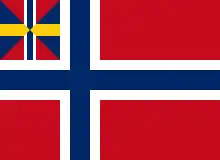Charles Alexander, Grand Duke of Saxe-Weimar-Eisenach
Charles Alexander (Karl Alexander August Johann; 24 June 1818 – 5 January 1901) was the ruler of Saxe-Weimar-Eisenach as its grand duke from 1853 until his death.
| Karl Alexander | |||||
|---|---|---|---|---|---|
 | |||||
| Grand Duke of Saxe-Weimar-Eisenach | |||||
| Reign | 8 July 1853 – 5 January 1901 | ||||
| Predecessor | Charles Frederick | ||||
| Successor | William Ernest | ||||
| Born | 24 June 1818 Weimar | ||||
| Died | 5 January 1901 (aged 82) Weimar | ||||
| Burial | |||||
| Spouse | Sophie of the Netherlands | ||||
| Issue | Charles Augustus, Hereditary Grand Duke of Saxe-Weimar-Eisenach Marie, Princess Heinrich VII Reuss Princess Anna Sophia Elisabeth, Duchess Johann Albrecht of Mecklenburg | ||||
| |||||
| House | Saxe-Weimar-Eisenach | ||||
| Father | Charles Frederick, Grand Duke of Saxe-Weimar-Eisenach | ||||
| Mother | Maria Pavlovna of Russia | ||||
| Religion | Lutheranism | ||||
Biography
Born in Weimar, he was the second but eldest surviving son of Karl Frederick, Grand Duke of Saxe-Weimar-Eisenach and Grand Duchess Maria Pavlovna of Russia. His mother engaged as tutor for Karl the Swiss scholar Frédéric Soret who became a close acquaintance to Johann Wolfgang von Goethe.
When he was the Hereditary Grand Duke, Karl Alexander established a strong friendship with Fanny Lewald and Hans Christian Andersen, but this close relationship stopped in 1849 for the war against Denmark over the duchies of Schleswig-Holstein (the First German-Danish War). On 8 July 1853 his father died, and Karl Alexander became Grand Duke; but he stopped his constitutional accession until Goethe's birthday, on 28 August 1853.
The Danish author and poet Hans Christian Andersen was reportedly infatuated with Karl Alexander, writing "I quite love the young duke, he is the first of all princes that I really find attractive".[1]
Karl Alexander renovated Wartburg Castle, and left his traces in many places in Eisenach. He was the protector of Richard Wagner and Franz Liszt, retained the tradition of Weimar's classical period, and gave the old part of Weimar a new and better appearance with the establishment of the Herder monument, and the double monument for Goethe and Schiller. In 1860, he founded the Weimar Saxon-Grand Ducal Art School (with Arnold Böcklin, Franz von Lenbach and the plastic artist Reinhold Begas). As Grand Duke he was automatically rector, president of Jena University where he supported especially the collections among them prominently the Oriental Coin Cabinet.
In the Franco-Prussian War (1870–1871), Karl Alexander participated only in "Samaritan"; stressed, however, for his war entrance in favor of Schleswig in 1849. The Weimar Congress of the Goethe Federation (opposing the Lex Heinze) occurred towards the end of his reign, in November 1900 - that congress described his government as the Silver Age of Weimar.
He died at Weimar in 1901. Following his death, he was succeeded as Grand Duke by his grandson Wilhelm Ernst, his only son Carl August having predeceased him.
Family and children
At Kneuterdijk Palace in The Hague, on 8 October 1842, Karl Alexander married with his first cousin, Princess Sophie of the Netherlands, daughter of William II and Grand Duchess Anna Pavlovna of Russia, sister of his mother. They had four children:
- Karl August Wilhelm Nicolaus Alexander Michael Bernhard Heinrich Frederick Stefan, Hereditary Grand Duke of Saxe-Weimar-Eisenach (b. Weimar, 31 July 1844 – d. Cap Martin, France, 20 November 1894).
- Marie Anna Alexandrine Sophie Auguste Helene (b. Weimar, 20 January 1849 – d. Trebschen, 6 May 1922), known as Marie; married on 6 February 1876 to Prince Heinrich VII Reuss of Köstritz.
- Maria Anna Sophia Elisabeth Bernhardine Ida Auguste Helene (b. Weimar, 29 March 1851 – d. Weimar, 26 April 1859), known as Anna.
- Elisabeth Sibylle Maria Dorothea Anna Amalie Luise (b. Weimar, 28 February 1854 – d. Wiligrad, 10 July 1908), known as Elisabeth; married on 6 November 1886 to Duke Johann Albrecht of Mecklenburg-Schwerin.
Honours and awards
He received the following awards:[2][3]
- German honours
.svg.png.webp) Saxe-Weimar-Eisenach: Grand Cross of the White Falcon, 7 July 1818;[4] Grand Master, 8 July 1853
Saxe-Weimar-Eisenach: Grand Cross of the White Falcon, 7 July 1818;[4] Grand Master, 8 July 1853.svg.png.webp)
.svg.png.webp)
.svg.png.webp) Ernestine duchies: Grand Cross of the Saxe-Ernestine House Order, February 1842[5]
Ernestine duchies: Grand Cross of the Saxe-Ernestine House Order, February 1842[5].svg.png.webp) Saxony: Knight of the Rue Crown, 1841[6]
Saxony: Knight of the Rue Crown, 1841[6] Ascanian duchies: Grand Cross of Albert the Bear, 16 March 1852[7]
Ascanian duchies: Grand Cross of Albert the Bear, 16 March 1852[7].svg.png.webp) Baden:
Baden:
- Knight of the House Order of Fidelity, 1853[8]
- Grand Cross of the Zähringer Lion
.svg.png.webp) Bavaria: Knight of St. Hubert, 1864[9]
Bavaria: Knight of St. Hubert, 1864[9] Brunswick: Grand Cross of Henry the Lion, 1859[10]
Brunswick: Grand Cross of Henry the Lion, 1859[10] Hesse and by Rhine: Grand Cross of the Ludwig Order, 5 August 1840[11]
Hesse and by Rhine: Grand Cross of the Ludwig Order, 5 August 1840[11] Hanover:[12]
Hanover:[12]
- Grand Cross of the Royal Guelphic Order, 1849
- Knight of St. George, 1857
 Mecklenburg: Grand Cross of the Wendish Crown, with Crown in Ore
Mecklenburg: Grand Cross of the Wendish Crown, with Crown in Ore.svg.png.webp) Nassau: Knight of the Gold Lion of Nassau, September 1858[13]
Nassau: Knight of the Gold Lion of Nassau, September 1858[13] Oldenburg: Grand Cross of the Order of Duke Peter Friedrich Ludwig, with Golden Crown, 25 April 1844[14]
Oldenburg: Grand Cross of the Order of Duke Peter Friedrich Ludwig, with Golden Crown, 25 April 1844[14].svg.png.webp) Prussia:
Prussia:
- Knight of the Black Eagle, with Collar, 14 June 1838[15]
- Grand Cross of the Red Eagle
- Grand Commander of the Royal House Order of Hohenzollern
- Grand Cross of the Iron Cross
- War Commemorative Medal of 1870/71
 Schaumburg-Lippe: Military Merit Medal, with Swords
Schaumburg-Lippe: Military Merit Medal, with Swords Württemberg: Grand Cross of the Württemberg Crown, 1851[16]
Württemberg: Grand Cross of the Württemberg Crown, 1851[16]
- Foreign honours
 Austrian Empire: Grand Cross of St. Stephen, 1843[17]
Austrian Empire: Grand Cross of St. Stephen, 1843[17].svg.png.webp) Belgium: Grand Cordon of the Order of Leopold, 26 July 1853[18]
Belgium: Grand Cordon of the Order of Leopold, 26 July 1853[18].svg.png.webp) Empire of Brazil: Grand Cross of the Southern Cross
Empire of Brazil: Grand Cross of the Southern Cross Denmark: Knight of the Elephant, 1 July 1878[19]
Denmark: Knight of the Elephant, 1 July 1878[19].svg.png.webp) French Empire: Grand Cross of the Legion of Honour, 10 October 1860[20]
French Empire: Grand Cross of the Legion of Honour, 10 October 1860[20]_crowned.svg.png.webp) Kingdom of Italy: Knight of the Annunciation, with Collar, 22 October 1885[21]
Kingdom of Italy: Knight of the Annunciation, with Collar, 22 October 1885[21].svg.png.webp) Empire of Japan: Grand Cordon of the Order of the Chrysanthemum, 9 March 1882[22]
Empire of Japan: Grand Cordon of the Order of the Chrysanthemum, 9 March 1882[22] Netherlands:
Netherlands:
- Grand Cross of the Netherlands Lion
- Grand Cross of the Military William Order
.svg.png.webp) Kingdom of Portugal: Grand Cross of the Tower and Sword, 1854
Kingdom of Portugal: Grand Cross of the Tower and Sword, 1854 Russian Empire:
Russian Empire:
- Knight of St. Andrew, with Collar
- Knight of St. Alexander Nevsky
- Knight of the White Eagle
- Knight of St. Anna, 1st Class
- Knight of St. George, 4th Class
.svg.png.webp) Spain:
Spain:
- Grand Cross of the Order of Charles III, 10 December 1861[23]
- Knight of the Golden Fleece, with Collar, 1 June 1875[24]
.svg.png.webp)
 Sweden-Norway:
Sweden-Norway:
- Knight of the Seraphim, 9 June 1875[25]
- Grand Cross of St. Olav, 23 July 1882[26]
.svg.png.webp) Grand Duchy of Tuscany: Grand Cross of St. Joseph
Grand Duchy of Tuscany: Grand Cross of St. Joseph
Ancestry
References
- His dark materials Archived 2007-03-14 at the Wayback Machine, The Independent, 27 March 2005.
- Staatshandbuch für das Großherzogtum Sachsen / Sachsen-Weimar-Eisenach (1900), "Genealogie" pp. 1-2
- Justus Perthes, Almanach de Gotha (1901) page 84
- Staatshandbuch für das ... Sachsen-Weimar-Eisenach (1851), "Großherzoglicher Hausorden" p. 7
- Staatshandbücher für das Herzogtum Sachsen-Coburg und Gotha (1847), "Herzogliche Sachsen-Ernestinischer Hausorden" p. 26
- Staatshandbuch für den Freistaat Sachsen: 1870. Heinrich. 1870. p. 3.
- Hof- und Staats-Handbuch des Herzogtum Anhalt (1867) "Herzoglicher Haus-orden Albrecht des Bären" p. 17
- Hof- und Staats-Handbuch des Großherzogtum Baden (1865), "Großherzogliche Orden" p. 54
- Hof- und Staatshandbuch des Königreichs Bayern: 1877. Landesamt. 1877. p. 8.
- Braunschweigisches Adreßbuch für das Jahr 1896. p. 3
- Hof- und Staats-Handbuch des Großherzogtum Hessen (1879), "Großherzogliche Orden und Ehrenzeichen" p. 10
- Staat Hannover (1865). Hof- und Staatshandbuch für das Königreich Hannover: 1865. Berenberg. pp. 38, 76.
- Staats- und Adreß-Handbuch des Herzogthums Nassau (1866), "Herzogliche Orden" p. 8
- Staat Oldenburg (1873). Hof- und Staatshandbuch des Großherzogtums Oldenburg: für ... 1872/73. Schulze. p. 29.
- Liste der Ritter des Königlich Preußischen Hohen Ordens vom Schwarzen Adler (1851), "Von Seiner Majestät dem Könige Friedrich Wilhelm III. ernannte Ritter" p. 20
- Hof- und Staats-Handbuch des Königreich Württemberg (1896), "Königliche Orden" p. 27
- "A Szent István Rend tagjai" Archived 22 December 2010 at the Wayback Machine
- H. Tarlier (1854). Almanach royal officiel, publié, exécution d'un arrête du roi (in French). 1. p. 37.
- Jørgen Pedersen (2009). Riddere af Elefantordenen, 1559–2009 (in Danish). Syddansk Universitetsforlag. p. 469. ISBN 978-87-7674-434-2.
- M. & B. Wattel (2009). Les Grand'Croix de la Légion d'honneur de 1805 à nos jours. Titulaires français et étrangers. Paris: Archives & Culture. p. 523. ISBN 978-2-35077-135-9.
- Italia : Ministero dell'interno (1898). Calendario generale del Regno d'Italia. Unione tipografico-editrice. p. 54.
- 刑部芳則 (2017). 明治時代の勲章外交儀礼 (PDF) (in Japanese). 明治聖徳記念学会紀要. p. 143.
- "Real y distinguida orden de Carlos III", Guía Oficial de España (in Spanish), 1887, p. 158, retrieved 21 March 2019
- "Caballeros de la insigne orden del toisón de oro", Guía Oficial de España (in Spanish), 1887, p. 146, retrieved 21 March 2019
- "Sveriges statskalender (1877) p.369" (in Swedish). Retrieved 2018-01-06 – via runeberg.org.
- "Norges Statskalender (1890) pp. 595-596" (in Swedish). Retrieved 2018-01-06 – via runeberg.org.
External links
| Wikimedia Commons has media related to Charles Alexander, Grand Duke of Saxe-Weimar-Eisenach. |
| German royalty | ||
|---|---|---|
| Preceded by Karl Frederick |
Grand Duke of Saxe-Weimar-Eisenach 1853–1901 |
Succeeded by Wilhelm Ernst |